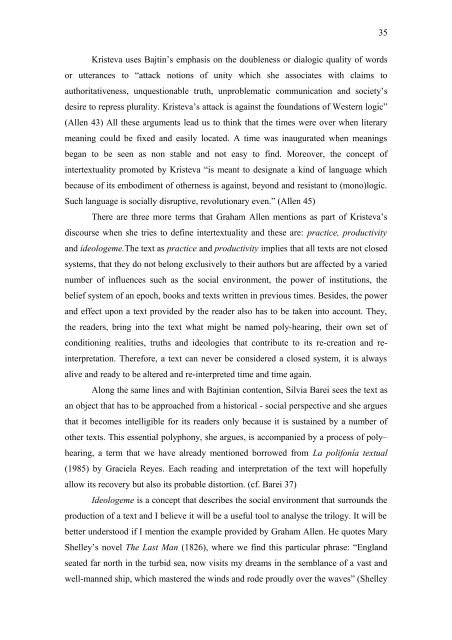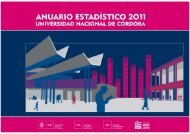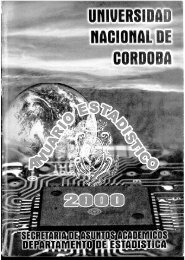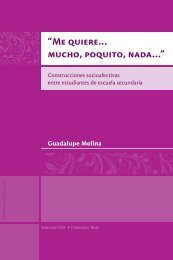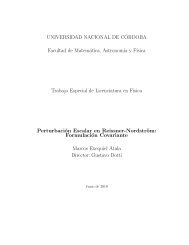Chapter I - RDU - Universidad Nacional de Córdoba
Chapter I - RDU - Universidad Nacional de Córdoba
Chapter I - RDU - Universidad Nacional de Córdoba
You also want an ePaper? Increase the reach of your titles
YUMPU automatically turns print PDFs into web optimized ePapers that Google loves.
35Kristeva uses Bajtin’s emphasis on the doubleness or dialogic quality of wordsor utterances to “attack notions of unity which she associates with claims toauthoritativeness, unquestionable truth, unproblematic communication and society’s<strong>de</strong>sire to repress plurality. Kristeva’s attack is against the foundations of Western logic”(Allen 43) All these arguments lead us to think that the times were over when literarymeaning could be fixed and easily located. A time was inaugurated when meaningsbegan to be seen as non stable and not easy to find. Moreover, the concept ofintertextuality promoted by Kristeva “is meant to <strong>de</strong>signate a kind of language whichbecause of its embodiment of otherness is against, beyond and resistant to (mono)logic.Such language is socially disruptive, revolutionary even.” (Allen 45)There are three more terms that Graham Allen mentions as part of Kristeva’sdiscourse when she tries to <strong>de</strong>fine intertextuality and these are: practice, productivityand i<strong>de</strong>ologeme.The text as practice and productivity implies that all texts are not closedsystems, that they do not belong exclusively to their authors but are affected by a variednumber of influences such as the social environment, the power of institutions, thebelief system of an epoch, books and texts written in previous times. Besi<strong>de</strong>s, the powerand effect upon a text provi<strong>de</strong>d by the rea<strong>de</strong>r also has to be taken into account. They,the rea<strong>de</strong>rs, bring into the text what might be named poly-hearing, their own set ofconditioning realities, truths and i<strong>de</strong>ologies that contribute to its re-creation and reinterpretation.Therefore, a text can never be consi<strong>de</strong>red a closed system, it is alwaysalive and ready to be altered and re-interpreted time and time again.Along the same lines and with Bajtinian contention, Silvia Barei sees the text asan object that has to be approached from a historical - social perspective and she arguesthat it becomes intelligible for its rea<strong>de</strong>rs only because it is sustained by a number ofother texts. This essential polyphony, she argues, is accompanied by a process of poly–hearing, a term that we have already mentioned borrowed from La polifonía textual(1985) by Graciela Reyes. Each reading and interpretation of the text will hopefullyallow its recovery but also its probable distortion. (cf. Barei 37)I<strong>de</strong>ologeme is a concept that <strong>de</strong>scribes the social environment that surrounds theproduction of a text and I believe it will be a useful tool to analyse the trilogy. It will bebetter un<strong>de</strong>rstood if I mention the example provi<strong>de</strong>d by Graham Allen. He quotes MaryShelley’s novel The Last Man (1826), where we find this particular phrase: “Englandseated far north in the turbid sea, now visits my dreams in the semblance of a vast andwell-manned ship, which mastered the winds and ro<strong>de</strong> proudly over the waves” (Shelley


